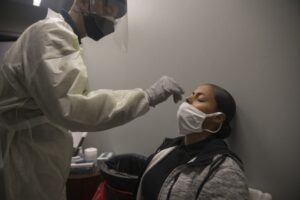New Study Examines the Role of Comorbidities

Rct. Aniya L. Allen with Lima Company, 3rd Recruit Training Battalion, is medically screened prior to arriving at the Marine Corps Recruit Depot in San Diego last year. All services now routinely screen recruits for sickle cell trait and sickle cell disease. Photo by Sg. Brooke C. Woods
DOVER, DE — Sickle cell trait (SCT), a condition in which a person has one abnormal allele of the hemoglobin beta gene, affects an estimated 5.02% of non-Hispanic blacks, 1.08% of Hispanics and 0.1% of whites in the U.S. military.
For most with the gene variation, SCT is not associated with any symptoms, but in rare cases, patients with SCT might experience complications of sickle cell disease such as “pain crises” and, in extreme circumstances, sudden death, according to the national Centers for Disease Control and Prevention. In these rare cases, problems have been found to occur in response to increased pressure in the atmosphere (e.g., while scuba diving), low oxygen levels in the air (e.g., when mountain-climbing), extreme exertion and dehydration.
Due to the potential for such problems related to military training or service, all four branches of the military perform some level of screening for sickle cells trait. But screening—and its implications for military service—have met with some controversy, with some studies even questioning its necessity.
In a study published in 2018 in Military Medicine, for example, researchers from the Uniformed Services of the Health Sciences and Walter Reed National Military Medical Center conducted a retrospective cohort study of 15,081 SCT-positive vs. 60,320 SCT-negative U.S. active duty personnel enlisted from 1992 to 2012 and followed through 2013. They determined that SCT-positive servicemembers deployed more frequently, for greater lengths of time, and remained in service longer. Yet, according to the authors, “no significant difference in crude mortality ratio was discovered. Additional research on military-relevant outcomes and a cost-effectiveness analysis of SCT screening practices are needed to inform evidence-based SCT enlistment policies.”1
A new paper published this fall in the American Journal of Forensic Medicine and Pathology suggested, however, death related to SCT may be underestimated, and an understanding of the risks of SCT to military personnel and others requires more than screening for the trait itself.2
The report was from the Class of 2023, Uniformed Services University in Bethesda, MD, the San Antonio Uniformed Services Health Education Consortium and two agencies in Dover, DE—Forensic Pathology Investigations, Armed Forces Medical Examiner System (AFMES) and Defense POW/MIA Accounting Agency (DPAA).
The paper begins with a case study of a 53-year-old African-American man who died unexpectedly. The autopsy of the man, who had no history of diabetes, showed changes consistent with the presence of undiagnosed diabetes with sickle cell crisis.
Diabetes Test Accuracy
According to the authors of this paper, while the identification of a new diagnosis of Type 2 diabetes mellitus, as the cause of death, was not uncommon, the case indicates that Type 2 diabetes was not the sole contributing factor. They noted that the presence of sickle trait might limit the accuracy of measuring hemoglobin A1c, the test most commonly used to diagnose and monitor diabetes.
“This case represented a complex interaction of multiple pathophysiology that remains poorly understood,” said Navy Lt. Cmdr. John Walsh, deputy medical examiner at Forensic Pathology Investigations, Armed Forces Medical Examiner System, and one of the study’s authors.
This case represented a complex interaction of multiple pathophysiological processes that remain poorly understood, Walsh pointed out. He said that SCT might have its own pathologic contributions to a person’s health in addition to synergistic effects with other pathologic processes. “SCT along with comorbidities such as [type 2 diabetes] and [hypertension] cannot and shouldn’t necessarily be considered two separate diseases that should be managed independently,” he said. “Furthermore, external factors such as a person’s job requirements should be considered.”
Noting that diabetes is a “routine” disease, Walsh said the impact of SCT on “routine” disease processes is poorly understood. It is not clear how to best manage the condition, an issue which often is further complicated by the servicemember’s job requirements. “The added complexity of military service increases the need to understand the pathophysiology of SCT and its synergistic interactions with other disease processes or complex military operations—altitude, cold weather, hot weather, etc.,” he explained.
“Better understanding of SCT and synergistic pathophysiology allows for better management and individual risk mitigation while maintaining diversity, equity, and inclusion that the military is striving for,” Walsh noted. “Maybe a service member shouldn’t be qualified for ‘X’ [military occupational specialty] but can be a highly functional contributory member in ‘Y’ field. Until SCT and synergistic pathophysiology is better understood, it is challenging to craft policy.”
Because death related to SCT and sickle cell disease can be missed and attributed to other causes at autopsy, the authors proposed a “stringent literature review in conjunction with a review of international autopsy standards to develop national autopsy standards and possible SCT/SCD screening recommendations for high-risk persons at the time of autopsy.”
- Singer DE, Chen L, Shao S, Goldsmith J, Byrne C, Niebuhr DW. The Association Between Sickle Cell Trait in U.S. Service Members with Deployment, Length of Service, and Mortality, 1992-2012. Mil Med. 2018 Mar 1;183(3-4):e213-e218. doi: 10.1093/milmed/usx037. PMID: 29514337; PMCID: PMC6544874.
- Dau GE, Shah JJ, Walsh JC, Berran PJ. Sudden Death in Diabetic Ketoacidosis Complicated by Sickle Cell Trait. Am J Forensic Med Pathol. 2022 Sep 1;43(3):277-281. doi: 10.1097/PAF.0000000000000751. Epub 2022 Feb 9. PMID: 35135968.

